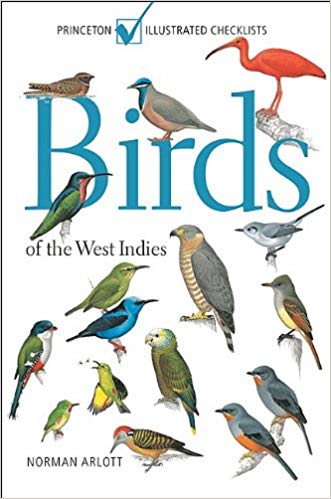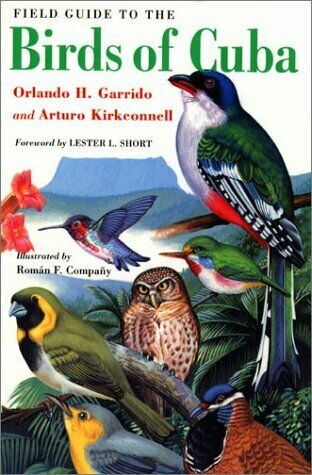The islands of the Caribbean, or more correctly, the West Indies, are divided into three groups: the Greater Antilles, the Lesser Antilles, and the Bahama Islands.
The Greater Antilles consists of the largest islands in the Caribbean, namely Cuba, Jamaica, Hispaniola and Puerto Rico, plus the small Cayman Islands and the Virgin Islands.
The Bahamas Archpeligo also includes the Turks and Caicos Islands.
The Lesser Antilles consists of the many small island countries between the Virgin Islands and the coast of South America.
West Indies

Princeton Guide to Birds of the West Indies by Norman Arlott 2010.
A good field guide covering more than 550 species of all the islands of the Caribbean.
This guide is a good size to carry in the field. It is arranged with drawings of birds on the right and text on the left. The illustrations are very good, but mostly, there is just one drawing per species. When there is more than one drawing of a species, it is often very small. There are six to nine species per page, sometimes as many as eleven.
The text gives good information about the bird, such as feeding habits, voice, and habitat. It also tells you which of the Caribbean Islands the species can be found and the abundance or if it is a migrant, which is all very good information. However, there is no information on how to ID the species other than the drawing. There are no specific points to look for in the drawings to aid with ID and no mention of similar species that could be mistaken for the bird in question. There is no mention of which taxonomic checklist the book is following.
Very good maps show not only which island any given species may be found on but also whether it is present only in the breeding season, only in the non-breeding season, or is a permanent resident. They also show whether the species is found at sea between the islands. The only problem with the maps is that they are located in a separate section at the back of the book instead of together with the text and photos, which is not very good.
There is a single index for both English and scientific names, but the print is very small, making it more difficult to peruse.
The book is well-printed on quality paper. However, it is not the best guidebook. Most people only visit one or two islands at a time and do not need a book that covers the whole Caribbean. However, some small islands may not have a dedicated book, so this one may be the only guide available.
Birdtripper members get 30% off Princeton books. Click members to register.
(M) Write a review
You must be logged in to submit a review. Go to Members page to Log-in or Register
Cuba

Cornell University Press Field Guide to the Birds of Cuba by Orlando Garrido and Arturo Kirkconnell 2000.
If you are going birding in Cuba, don’t bother with the book on Birds of the West Indies. Get this one instead.
Cuba is a great birding destination. Depending on which taxonomic checklist you use, there are 25 to 28 endemics in Cuba.
It is a bit large for a field guide, but that is because it is packed with tons of information on the birds of Cuba. It covers 354 species and has 662 images.
The book does not follow the standard field guide layout. It has excellent drawings of all the birds, but they are located in a separate section from the text. The high-quality drawings are very detailed, and there are usually two or more for each species. However, the species are not named. Instead, for each page of drawings, there is a corresponding page in greyscale that gives the name of the species in English and the scientific name and the difference between drawings of one species, such as which is the adult, immature or female versions. This is a very strange layout. It would have been much better to name the bird on the same page as the drawing and eliminate a duplicate page for each colour plate. Also, it would be much better if the drawings and text were colocated. Another problem is that there is no link between the drawings and the text, so we wrote the page number for the corresponding text beside each drawing.
The white and grey maps, located together with the text, show only where on the island the species may be found but do not indicate whether the bird is there year-round. Most species have a map, but many do not.
The book follows the AOU taxonomic order. The text is very detailed, giving information on how to ID the species as well as information on similar species that might be confused with the book you are looking for, the range, abundance, nesting seasons and food.
There is a single index for both English and scientific names, but English names are in bold.
Additional Features
In addition to the usual data found in a typical field guide, this book also has a section at the front with a lot of information on birding in Cuba. There is also a list of endemic species and where to find them. However, it is a bit out of date as recent taxonomic changes indicate between 25 and 28 endemic species in Cuba, depending on which checklist you use. There is also a glossary of birding terminology.
In summary, the book is a bit too large to carry in the field, and the relatively thin cover tends to curl up after a few days of use. Despite that, it is a valuable book for birding in Cuba, with excellent drawings and detailed text once you get used to the strange layout.
As mentioned above, it is a good idea to write the page number with each drawing to find the corresponding text. The text gives you the page for the corresponding drawing, but it does not work the other way around.
(M) Write a review
You must be logged in to submit a review. Go to Members page to Log-in or Register
Birds – Caribbean
We have not reviewed field guides for other island countries in the Caribbean, such as Jamaica. If you are a member of Birdtripper, you can write a review and email it to us.